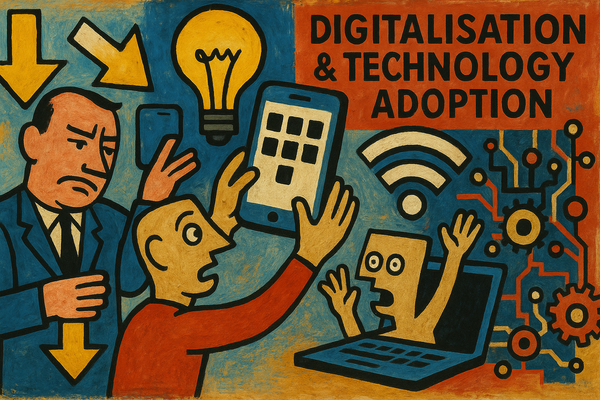Let’s (Not) Get Physical: Why Adding Physical Versions to Digital Products Can Undermine Their Value
New research by Rob Angell shows that adding physical versions to unique digital assets can reduce their value. This article explores the cross-format dilution effect and its implications for digital marketing strategy.

As brands extend their presence into digital environments—from the metaverse to blockchain-enabled marketplaces—the question of how to structure digital product offerings becomes increasingly significant. In particular, the rise of unique digital assets (UDAs), such as NFTs (Non-Fungible Token) used for virtual sneakers, digital fashion, or avatar accessories, has opened up new commercial models for ownership and consumer engagement. These digital items are often framed as limited, scarce, and high-value, and the consumer’s response depends as much on perception as on function.
For many, the appeal of these assets is psychological: they are unique, exclusive, and anchored in the logic of digital scarcity.
Yet, despite their intangible form, these assets are increasingly being accompanied by tangible counterparts—physical products made available to buyers in parallel or shortly after a 'digital drop'. The rationale appears sound at first glance: leverage a single product design across multiple channels, appeal to a broader consumer base, and build cross-format brand visibility. But what if this strategy, rather than enhancing appeal, actually dilutes it? What if the introduction of a physical version erodes the perceived uniqueness that made the digital asset desirable in the first place?
the “cross-format dilution effect”
This is the central question posed by a new paper co-authored by Rob Angell and colleagues, recently published in the Journal of Retailing. Their research, based on a series of six carefully structured experiments, identifies a counterintuitive effect: offering a physical counterpart to a unique digital asset tends to reduce consumers’ willingness to pay for the digital version and lowers their intent to purchase. This phenomenon—what the authors term the “cross-format dilution effect”—emerges not from any flaw in the digital product itself, but from a psychological shift in how ownership and uniqueness are perceived when exclusivity is compromised by physical replication.

What the Study Found
The research conducted by Hua Fang, Khloé Qi Kang, Jennifer Yule, Ben Marder, and Rob Angell set out to explore how consumers evaluate digital assets when those assets are made available in more than one format. Specifically, they examined whether a unique digital asset (UDA)—such as a piece of NFT artwork or a branded digital sneaker—is viewed differently when it is sold exclusively in digital form versus when it is accompanied by a physical version. Across six experiments, they consistently found that UDAs available only in digital form elicited stronger consumer interest and higher willingness to pay than their dual-format counterparts.
psychological ownership
The explanation for this effect lies in what the authors describe as psychological ownership. When consumers perceive a digital item as unique—available only in the virtual space—they develop a stronger affective connection to it. This sense of ownership is anticipatory in nature: it emerges not from having already acquired the item, but from the belief that it is special and exclusively theirs. By contrast, the introduction of a physical counterpart undermines this perception. The item feels less scarce, less distinctive, and—crucially—less personalised. Even if the digital version remains unchanged, the mere existence of a tangible alternative changes how the consumer feels about it.
dual-format availability weakened the perceived uniqueness of the digital asset and, by extension, reduced purchase intent
This insight is not merely theoretical. In practical terms, the dilution effect was observed across a variety of digital asset types, including virtual art, sneakers, and collectible sports cards. Whether the product was positioned as decorative, wearable, or investment-grade, the pattern was consistent: dual-format availability weakened the perceived uniqueness of the digital asset and, by extension, reduced purchase intent. Notably, this dilution occurred even when consumers could not themselves purchase the physical version—what mattered was that others could. The availability of a physical product, even at a distance, was enough to compromise the exclusivity that underpins digital value.
This research challenges orthodoxy.
What I find most compelling about this work is the inversion it offers to conventional brand logic. For decades, marketing strategy has been preoccupied with format extension—physical to digital, single product to multi-channel. The assumption has been that broader availability enhances reach, and that physical presence adds credibility or value to what is otherwise intangible. This research challenges that orthodoxy. It suggests that in some cases, the absence of a physical version may be precisely what confers value in a digital context.

The implications are uncomfortable for marketers who treat digital assets as just another layer in a multichannel strategy. The data here reveal that exclusivity is not a gimmick—it is a psychological mechanism that underwrites desirability. Introducing a physical counterpart doesn’t just extend the product; it potentially undermines the very uniqueness that made the digital version valuable in the first place.
the metaverse is not just a new sales channel—it is a distinct psychological space that requires its own strategic logic
It also raises questions about how we interpret ownership in a world where presence is virtual and scarcity is designed. If digital consumers signal identity through uniqueness, and uniqueness depends on perceived isolation from the physical world, then the metaverse is not just a new sales channel—it is a distinct psychological space that requires its own strategic logic. That, to me, is the real contribution of this paper. It is not simply about NFTs. It is about how we build perceived value when the boundaries between real and virtual are no longer stable.

The Psychology of Digital Ownership
At the heart of this research lies the concept of psychological ownership—a construct from consumer psychology that describes the feeling that something is “mine” even in the absence of legal or physical possession. Traditionally, psychological ownership has been explored in relation to tangible goods: the well-worn seat in a coffee shop, the favourite side of the sofa, or the branded item that reflects personal taste. But in digital environments, ownership is less about possession and more about perception—about uniqueness, control, and identity signalling.
ownership is less about possession and more about perception
The study shows that psychological ownership is weakened when the perceived uniqueness of the digital asset is compromised. If other consumers can buy a physical version—even if it differs in format or medium—the digital version no longer feels quite as exclusive. This undermines the sense of individual attachment that consumers build through imagined or anticipated ownership. The asset becomes less “mine” and more “ours,” and in that shift, its value diminishes.
This is particularly relevant in the context of the metaverse, where avatars, virtual spaces, and digital collections function as expressions of identity. Consumers are not just buying utility; they are buying signals—indicators of distinctiveness, taste, and sometimes status. When the digital item is no longer rare, its power to signal these attributes is diluted. What the authors make clear is that this dilution is not accidental—it is structural. It emerges directly from the decision to replicate the asset in another format.
This insight complicates the common practice of bundling digital assets with physical products. Rather than adding value, the physical component can erode the very psychological dynamics that make the digital version desirable. The result is a powerful reminder that exclusivity is not merely a sales tactic; it is a form of perceived control and identity expression that must be protected if digital assets are to retain their appeal.
Implications for Brand Strategy
The practical implications of this research are clear, but not always intuitive. Brands operating in digital environments need to think carefully before defaulting to a cross-format strategy. The temptation to repurpose a digital asset into a physical product—or vice versa—may appear to offer economies of scale or broader reach. Yet the findings suggest that this move can actively diminish consumer interest in the digital version by undermining its perceived uniqueness.
not all value is additive
The key strategic takeaway is that not all value is additive. In the case of unique digital assets, value is often constructed through scarcity, distinctiveness, and the absence of alternatives. Making a physical version available—even without altering the digital one—can interfere with these cues. If the goal is to drive up purchase intent and willingness to pay for digital goods, then marketers must pay close attention to how exclusivity is framed, and more importantly, how it is protected.
The study also offers two concrete interventions. First, the dilution effect can be reduced if the physical version is displayed but not made available for purchase—think of it as a showroom piece or symbolic artefact. Second, launch order matters. When the digital asset is introduced first, it retains the primacy effect in consumer memory, which helps reinforce its perceived originality. By contrast, releasing the physical version first can cast the digital product as a derivative or imitation, reducing its psychological impact.
For marketers and product strategists, these insights invite a rethinking of how digital value is constructed and sustained. Exclusivity in the digital space does not simply echo physical scarcity—it is a distinct form of value creation that relies on signalling, identity expression, and perceived control. Brands that ignore this dynamic risk undermining the very assets they seek to monetise.

This study invites us to reconsider how we define value in a digital economy increasingly structured around ownership without physicality. While marketers have spent decades learning how to replicate physical brand assets into digital forms—webshops, social content, augmented packaging—this research suggests that the inverse process requires a different logic. When an item is born digital, its value may be more fragile, more dependent on its status as unique, untouchable, and exclusive to the environment in which it was created.
Psychological ownership may be intangible, but it shapes very real behaviours
The broader question is what happens to consumer-brand relationships when digital ownership is mediated more by perception than possession. Psychological ownership may be intangible, but it shapes very real behaviours—how much people are willing to pay, how likely they are to recommend, and whether they feel connected to a brand. As brands design strategies for the metaverse and beyond, they would do well to understand that exclusivity is not just a price point or distribution tactic. It is a psychological lever, and one that must be pulled with care.
About the Authors
This article reflects on a recent publication co-authored Hua Fang, Khloé Qi Kang, Jennifer Yule, Ben Marder, and Rob Angell. Professor Rob Angell is also an anchor here at 1541.co.uk. The study, titled “Let’s (NOT) Get Physical: Cross-format dilution when launching physical counterparts with unique digital assets”, appears in the Journal of Retailing and was written in collaboration with Hua Fang (Zhongnan University of Economics and Law), Khloé Qi Kang (Léonard de Vinci Pôle Universitaire), Jennifer Yule, and Ben Marder (University of Edinburgh). It offers one of the first empirical examinations of how product format influences psychological ownership in the context of digital consumption.
Rob’s ongoing work explores the intersections of consumer behaviour, digital innovation, and methodological rigour. His contribution to this study continues a line of enquiry that bridges academic theory and actionable insight—something we value deeply at 1541.co.uk.
Non-Fungible Token
a unique digital asset stored on a blockchain that certifies ownership and provenance. Unlike cryptocurrencies such as Bitcoin or Ethereum (which are fungible, meaning each unit is identical), each NFT is distinct and cannot be exchanged on a one-to-one basis with another. This uniqueness makes NFTs well suited for digital art, collectibles, virtual fashion, and other items where exclusivity and ownership are central to perceived value.




